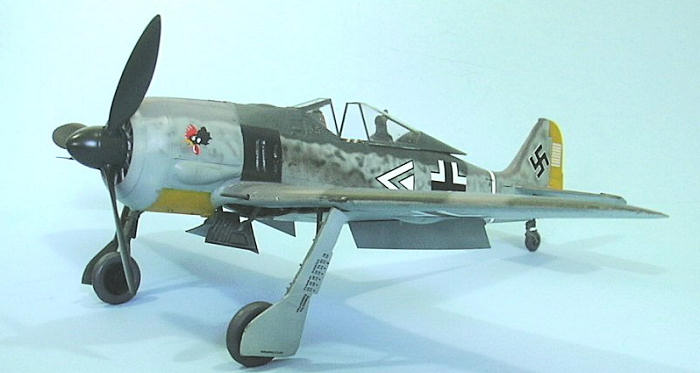
| KIT #: | 08169 |
| PRICE: | $42.95 MSRP for the FW-190A-5 kit (currently unavailable) |
| DECALS: | Eagle Edition markings used. |
| REVIEWER: | Tom Cleaver |
| NOTES: | Montex K-32114 1/32 FW-190A-3 conversion set used ($79.95 MSRP) |

| HISTORY |
RAF pilots first reported encountering a new German
radial-engine fighter on cross-Channel missions beginning in August 1941 and
increasingly in September, though their main opponents were still Bf-109Fs.
Their reports of its incredible flying abilities were
met with official disbelief on the part of RAF intelligence (which did in fact
know about the airplane), and pilots were initially told they must have run
across ex-French Hawk-75s being used by the Germans because they were “scraping
the bottom of the barrel.”
In his book “Wing Leader,” Johnny Johnson relates that
the intelligence officer was run out of the room by the pilots who had just
survived an encounter with these “Hawk 75s” when that announcement was made, as
the pilots exclaimed that no pre-war fighter could perform like the airplane
they had just fought. RAF HQ finally admitted that the airplane was the new
Focke-Wulf Fw-190.
In February 1942, the RAF came up full against the
Focke-Wulf during the “Channel Dash,” when the defending Germans decimated the
British attackers.
In March 1942, more of these phenomenal airplanes were
encountered as the two Jagdgeschwadern
on the Channel Front re-equipped with the airplane, and it appeared their
performance was even better than those the RAF had first run across the previous
fall.
By April all of the German units opposing the RAF on the Channel coast
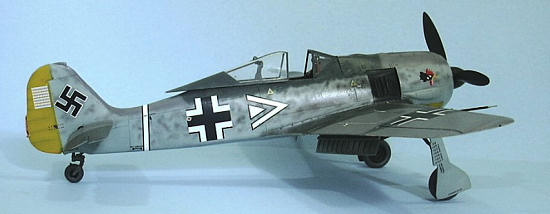 were completely equipped with the new fighter, and their ascendancy over their
RAF opponents was comparable to that of the Albatros D.III during “Bloody April”
of 1917; in fact April 1942 saw some of the highest RAF losses of the entire
war, with no fewer than 103 Spitfires shot down by the Focke-Wulf.
It was clear the fighter was superior to the Spitfire on
all counts other than its turning capability, to which Wing Commander Al Deere
commented, “turning doesn’t win battles!”
were completely equipped with the new fighter, and their ascendancy over their
RAF opponents was comparable to that of the Albatros D.III during “Bloody April”
of 1917; in fact April 1942 saw some of the highest RAF losses of the entire
war, with no fewer than 103 Spitfires shot down by the Focke-Wulf.
It was clear the fighter was superior to the Spitfire on
all counts other than its turning capability, to which Wing Commander Al Deere
commented, “turning doesn’t win battles!”
After a battle on June 1, 1942, that saw 10 Spitfires of
the Debden Wing, including the Wing Commander, shot down by JG 26, with another
10 Spitfires badly damaged - for what turned out to be no losses on the part of
the Germans despite RAF claims of three shot down - the RAF was desperate to get
hold of one of these airplanes and discover its secrets.
Plans were mounted for a commando raid on a German air
base, with the goal of putting a top British test pilot in the cockpit, and
stealing a Fw-190 to fly it back to England.
The RAF got lucky on the evening of June 23, 1942, when
the Portland and Exeter Spitfire wings returned from a support sweep over the
Brittany Peninsula.
After a short encounter with Fw-190s of JG2 during
withdrawal, the Spitfires broke off and returned across the Channel at low
altitude.
No one realized that they were being trailed by Fw-190s of the
Stab of JG2 and 7
Staffel, led by Egon Mayer, until the Germans dove on the
British fighters over Star Point on the Devon coast.
The Wing Commander was lost in a head-on collision with
one Focke-Wulf. At that point, all but one German turned back.
The lone Fw-190 proceeded over Exeter.
Four Spitfires were dispatched to intercept him, with
two crashing on take off, one returning with a bad radio, and the fourth was
shot down by the lone German.
The German fighter then crossed the Bristol Channel.
The pilots and ground crews at RAF Pembrey were amazed
minutes later to see a Fw-190 circle, drop its landing gear, and touch down on
the field.
Before the German could realize his mistake, an RAF officer
leaped on the wing and pointed a flare gun at him.
The RAF was now the proud owner of a brand-new
Fw-190A-3, fully equipped.
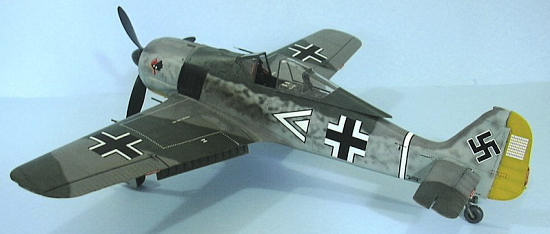 Rumors have surfaced over the years that the pilot of
the Fw-190, Oberleutnant Arnim Faber,
Adjutant of JG 2, had actually defected with his brand-new airplane, a victory
for MI6. Nothing definitive has ever been proven regarding this claim, even
though many other victories of British intelligence during the war have been
revealed in the years since the revelation of Ultra
in 1974, but it is interesting that Faber did not spend any time during the war
as a POW, and was known to be an anti-Nazi, a status that was more widespread
among Luftwaffe personnel than is
generally known.
Rumors have surfaced over the years that the pilot of
the Fw-190, Oberleutnant Arnim Faber,
Adjutant of JG 2, had actually defected with his brand-new airplane, a victory
for MI6. Nothing definitive has ever been proven regarding this claim, even
though many other victories of British intelligence during the war have been
revealed in the years since the revelation of Ultra
in 1974, but it is interesting that Faber did not spend any time during the war
as a POW, and was known to be an anti-Nazi, a status that was more widespread
among Luftwaffe personnel than is
generally known.
The first thing RAF tests revealed was that this
airplane had its engine derated by 200 horsepower
to extend the life of the engine!
This was at a time when the RAF was souping up Merlin
45s in Spitfire Vs to the point where they were making complete engine changes
every 50 hours after burning up the engine, in an attempt to keep up with the
new Focke-Wulf.
Adding insult to injury, tests demonstrated that the Fw-190
outperformed the Spitfire V on all points but turning circle below 25,000 feet,
and that a Focke-Wulf pilot could break off combat at will with any Spitfire V.
Aerobatics at all speeds were crisp, with the fastest
aileron roll of any fighter in the war, while controls remaining remarkably
light in a steep dive. Even the new Spitfire IX - brought into service
specifically to oppose the German fighter - was only marginally faster than the
Fw-190, and only at certain altitudes, with the Spitfire IX only coming into its
own above 25,000 feet. In maneuverability, the Fw-190 was superior, and could
get away from the British rival with a dive at any point in a fight.
All the RAF pilots who flew it were amazed at its
ability to flick roll equally well to left or right.
The first Allied fighter that was fully capable of
taking on the Fw-190 was the Merlin-powered P-51B Mustang, and even then the
superiority was only marginal.
It was only with the deterioration of flying personnel
that the Wurger was finally overcome.
My friend Corky Meyer, who was a Grumman test pilot
during the war, told me that when he first flew a captured Fw-190, his response
was that it was the most amazing airplane he had ever flown.
Grumman’s chief of design, Robert Hall, was so impressed
with the Fw-190 that he went and did his take on a “navalized Focke-Wulf”, which
resulted in the F8F Bearcat.
The RAF was similarly impressed, with the Hawker Fury
(later the Sea Fury) being directly influenced in its design by the Fw-190.
Every designer who ever saw the airplane was impressed
that it had the most successful closely-cowled radial engine they had ever seen.
Hans “Assi” Hahn:
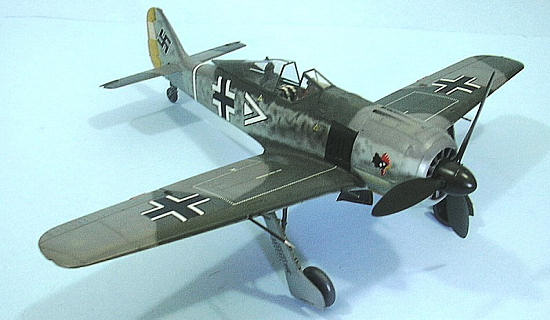 Hans “Assi” Hahn - who became one of the leading early
exponents of the Fw-190A - enlisted in the army on April 1, 1934 as an officer
candidate, and was promoted to Unteroffizier
on December 1. After attending the Kriegsschule
at München from January to October 1935, Hahn was promoted to
Oberfähnrich on October 1.
That November, Hahn transferred from the infantry to the
Luftwaffe, and took pilot training at Celle. He was promoted to
Leutnant on April 1, 1936, and was assigned to
4./JG 134, based at Werl near Dortmund until he was transferred to the
Jagdfliegerschule at Werneuchen as an instructor
in October 1937, being made Staffelführer
of 1. Staffel. He was promoted to
Oberleutnant on
February 1939 and was transferred to the
Stabstaffel of I./JG 3.
Oberleutnant Hahn was assigned JG 2
Richtofen on October 11, 1939 and assigned to the newly formed
II./JG 2, based at Zerbst. On December 15, 1939, he
was appointed Staffelkapitän of 4./JG
2. Hahn claimed his first two victories over RAF Hurricanes on May 14, 1940, in
his first engagement with enemy aircraft, though only one claim was confirmed.
He scored a total of 5 during the Battle of France and was particularly
successful in the Battle of Britain, claiming three Spitfires
shot down on August 31, 1940. After claiming his 20th
victory on
September 20, 1940, he was awarded the
Ritterkreuz.
Hans “Assi” Hahn - who became one of the leading early
exponents of the Fw-190A - enlisted in the army on April 1, 1934 as an officer
candidate, and was promoted to Unteroffizier
on December 1. After attending the Kriegsschule
at München from January to October 1935, Hahn was promoted to
Oberfähnrich on October 1.
That November, Hahn transferred from the infantry to the
Luftwaffe, and took pilot training at Celle. He was promoted to
Leutnant on April 1, 1936, and was assigned to
4./JG 134, based at Werl near Dortmund until he was transferred to the
Jagdfliegerschule at Werneuchen as an instructor
in October 1937, being made Staffelführer
of 1. Staffel. He was promoted to
Oberleutnant on
February 1939 and was transferred to the
Stabstaffel of I./JG 3.
Oberleutnant Hahn was assigned JG 2
Richtofen on October 11, 1939 and assigned to the newly formed
II./JG 2, based at Zerbst. On December 15, 1939, he
was appointed Staffelkapitän of 4./JG
2. Hahn claimed his first two victories over RAF Hurricanes on May 14, 1940, in
his first engagement with enemy aircraft, though only one claim was confirmed.
He scored a total of 5 during the Battle of France and was particularly
successful in the Battle of Britain, claiming three Spitfires
shot down on August 31, 1940. After claiming his 20th
victory on
September 20, 1940, he was awarded the
Ritterkreuz.
On October 29, 1940, Hahn was promoted to
Hauptmann and appointed
Gruppenkommandeur of III./JG 2. By the end of 1940, his
victory total had reached 22. Hauptmann
Hahn became the 32nd German soldier
awarded the Eichenlaub on August 14,
1941 for scoring 41 victories. He recorded his 50th victory on October 13, 1941
and his 60th on May 4, 1942. Hahn’s 66th, and last, victory over the Western
front was a RAF Spitfire fighter shot down on
September 16, 1942.
On November 1, 1942, Hahn was appointed as
Gruppenkommandeur of II./JG 54 “Grünherz”,
based on the Leningrad front. In the
three months following his arrival on the Eastern Front,
he claimed an additional 42 victories, shooting down five Russian
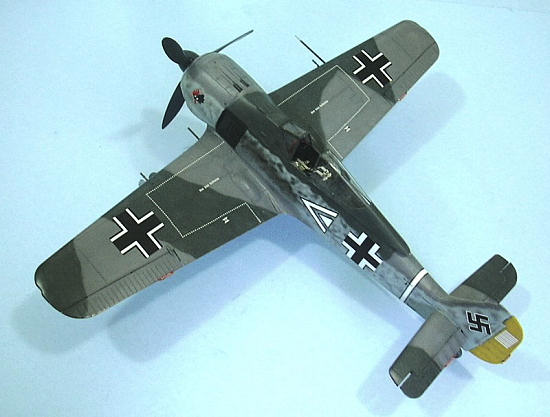 aircraft on
December 30, 1942. He was to Major on January 1, 1943. His best day was on
January 14, 1943, when he shot down seven La-5s. He scored his 100th victory on
January 27.
aircraft on
December 30, 1942. He was to Major on January 1, 1943. His best day was on
January 14, 1943, when he shot down seven La-5s. He scored his 100th victory on
January 27.
On February 21, while leading III./JG54, Hahn
encountered Russian fighters near Staraya Russa. He shot down a La-5 for his
108th, and last, victory. Immediately following this victory, he
received hits in his left wing. Disengaging, he headed
west but his engine soon
overheated and he crash landed his Bf 109 G-2/R6 in
enemy territory. Soviet sources claim Hahn was shot down by
Starshiiy Leytenant Pavel
Grazhdanikov, a 13 victory ace of 169 IAP, VVS, who was killed in action April
5, 1943. Hahn was captured and became a POW, being held captive until 1950.
Hahn made himself persona non grata
to the newly-formed post-war Luftwaffe
when he published a book in 1955 accusing several top German aces of
collaborating with the Soviets during their captivity.
He successfully entered international business after his
return to Germany, eventually retiring in 1977 when he moved to southern France
with his family. Hahn died on December 18, 1982, in München from cancer.
Hans Hahn was credited with 108 victories in 560 missions, with 66 victories over the Western Front, of which 53 were Spitfires. Of his 42 Eastern Front victories, seven were Il-2 Sturmovik ground-attack aircraft, a notoriously-difficult target.
| THE KIT |
The Hasegawa 1/32 Fw-190 has now been around for five
successful years, releasing Fw-190A-5 and Fw-190A-8 and F-8 versions of the
radial-engined version.
Surprisingly, they have yet to take off 3/8 inch from
the forward fuselage (which is even clearly delineated in panel lines) to create
the Fw-190A-3 and Fw-190A-4.
It’s likely that some day in the foreseeable future
Hasegawa will see fit to modify the fuselage of their 1/32 Fw-190A kit, and give
us the “short nose” Fw-190A-3 and Fw-190A-4.
That day could be tomorrow or it could be five years
from now.
Or never.
But for
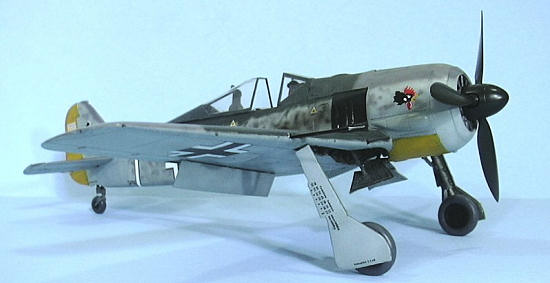 those who can’t wait, Montex has produced a
drop-fit resin fuselage conversion for the 1/32 Hasegawa Fw-190A-5 kit, that can
produce either an early or late Fw-190A-3, or an Fw-190A-4.
those who can’t wait, Montex has produced a
drop-fit resin fuselage conversion for the 1/32 Hasegawa Fw-190A-5 kit, that can
produce either an early or late Fw-190A-3, or an Fw-190A-4.
The parts consist of two fuselage halves, two different
sets of exhaust plates for the forward fuselage to create either the early or
the late version A-3, and the correct-length gun bay cover, and the lower rear
fuselage plate without the MW 50 installation. Additionally, there are resin
horizontal stabilizers and elevators, a rudder, and ailerons, all of which can
be posed dynamically.
The parts need a bit of clean-up and should be
test-fitted, but I experienced no trouble with this kit as I proceeded to make
an early Fw-190A-3.
Montex provides masks to do two different Fw-190A-3s if you don’t have a big enough decal spares box to come up with markings that can create an early Wurger. The kit markings are for an Fw-190A-3 of 8./JG 2 with the highly-stylized black and white “eagle” on the fuselage sides, and another A-3 from IV/JG 5 in Norway, in Eastern Front markings.
| CONSTRUCTION |
The resin parts were no problem, once I had sanded the
lower centerline seam smooth to clean it up.
Past that, the resin conversion was a “drop-fit” for the
kit fuselage.
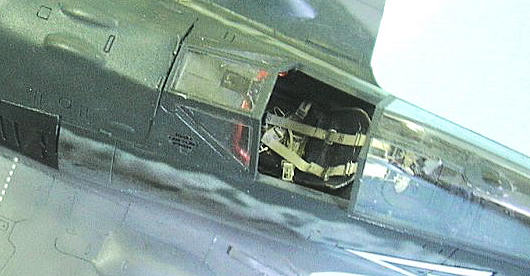 This conversion only works with the Fw-190A-5 kit, which
is currently out of production.
This kit provides the early gear doors, early cowling,
extended pitot tube, and the bulged gun bay covers for the MG FF wing guns.
The kits are still available at several online hobby
shops and for reasonable prices at eBay.
I thank the late kit collector who bought 6,000-odd kits
he never built before he died, for providing this kit which I bought at the LHS
for a non-collector price recently when his wife authorized a sell-off to clear
out the storage facility.
This conversion only works with the Fw-190A-5 kit, which
is currently out of production.
This kit provides the early gear doors, early cowling,
extended pitot tube, and the bulged gun bay covers for the MG FF wing guns.
The kits are still available at several online hobby
shops and for reasonable prices at eBay.
I thank the late kit collector who bought 6,000-odd kits
he never built before he died, for providing this kit which I bought at the LHS
for a non-collector price recently when his wife authorized a sell-off to clear
out the storage facility.
I did manage to create some “operator error” when gluing
the fuselage together with cyanoacrylate glue, resulting in a “tilted” vertical
fin that I did not notice until I had attached the wing and was checking overall
alignment.
This called for some industrial-strength pushing, shoving and
twisting, which resulted in cracks in the vertical fin.
These were repaired with cyanoacrylate glue, covered
with Mr. Surfacer, and finished with 10 minutes using sanding sticks and some
re-scribing.
If you are careful to align the rear fuselage halves before
applying any glue, you’ll easily avoid this problem.
| COLORS & MARKINGS |
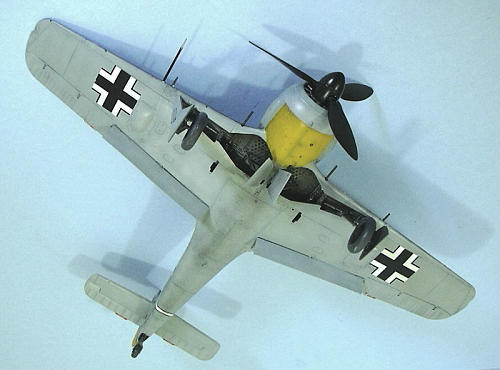 Painting:
Painting:
The model was given a standard 74/75/76 camouflage
scheme using Xtracrylix paints.
The yellow areas were done with Tamiya “Flat Yellow” and
masked before applying “pre-shading” and then doing the surface colors freehand.
Decals:
Montex provides masks for this kit, but I am not a fan
of doing markings that way (I am glad to note that their next full-resin kit,
the Yak-1b, will have decals for all markings).
I considered using the masks, but I had EagleCals Number
53 from their series “Assi Hahn: The Man And His Machines,” and I decided to do
his well-known Fw-190A-3.
The decals went on without trouble with a coat of
Micro-Sol.
| FINAL CONSTRUCTION |
I did the Eduard seatbelts and attached them to the
seat, which I then installed in the cockpit.
I assembled and attached the landing gear, the flaps,
and the prop, unmasked the canopy and attached it in the open position.
| CONCLUSIONS |
Personally, I like the Fw-190 better than the Bf-109.
I think it is aesthetically the best-looking radial-engined
fighter ever built.
With this Montex conversion giving me an early “short
nose,” I now have representative models of each of the major sub-types of this
classic fighter, from Fw-190A-3 to Ta-152H-1, in 1/32.
If you can’t wait for Hasegawa to get around to making
up their mind about doing the early Wurger,
this conversion from Montex is easy and the result looks great.
Thanks to Montex for the review kit. Hasegawa kit courtesy my billfold.
November 2008
If you would like your product reviewed fairly and quickly please contact me or see other details in the Note to Contributors.